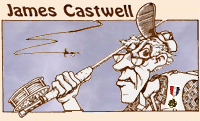|
By now you must have heard the tale that goes something
like this. A guy is in the Bahamas after bonefish and
within a few days his guide finally pays him a compliment.
He has spotted a bonefish out in front of the boat and even
made a cast to it before the guide told him where the fish
was. He was quite proud of himself too, receiving the
compliment, until the guide also mentioned that "it is
better to cast in front of the head of the fish, then
to cast in back of the tail."
As simple as that does sound, I can see it happening very
easily. Bonefish are very hard to see, nearly impossible
on many occasions. The scales are like mirrors and reflect
the surroundings well. Instant traveling camouflage.
Sometimes it is possible to see the shadow they leave on
the ocean floor but not see the fish itself. All of which
means that it is dandy to be able to see your fish, but
even better if you can tell which way he is pointed. Crucial
in fact.
I was on the phone tonight with Ray DuBois, a fishing
buddy from Connecticut and we were talking about how a
guy who can cast very well can spend one hundred percent
of his concentration on fishing, not casting, when he is
on the water. The fly just goes where it is supposed to,
automatically. Or pretty much does. Don=t take that as
arrogance or bragging. It is the way things should be and
for many is how it is. But sadly, far too many will not
take the time to practice casting, don-t know what to
practice, or are just not good enough at casting yet. They
have to concentrate on "fly casting" when they should be
"fly fishing." And then they make the big mistake.
They cast to the wrong place. They cast to the rise. The
rise is where the fish took something. It is the tell-tale
ring pattern that tells you a fish was just there. In a
stream it is moving with the speed of the stream. When you
see it, it has already moved downstream some. Alright,
upstream if there is a small whirl-pool effect, but mostly
it went along with the surface water.
So where do you put your cast. Your dry fly. If it was a
surface rise I presume you are using a dry fly. If the fish
took "in the surface" it was an emerger and if the "rise"
was just a bulge he took a nymph just under the surface.
You probably saw his dorsal fin and tail. Anyway, you cast
upstream from it. Right? Yes. But, how far upstream? This
is where many guys get it wrong, not by a lot, but enough
to either put the fish "down" or to at least make sure he
will not take your fly.
Keep in mind that the fish tipped up and opened his mouth
and something dropped into it. How far did he drift along
with the current as he rose from the bottom of the stream?
How deep is the water? Did he drift back with it or did he
chase it downstream? Too many fly fishers will make the
mistake of not casting far enough ahead of the fish and
here is why.
The deeper in the stream he is, the farther the fish can see
"out of the water" upstream. He sees out of the water at
about a forty-five degree angle, so if he is down two feet,
he can see out through his window about two feet ahead. He
can see the impressions of anything on the surface farther
than that. Footprints. Dimples on, or in the surface. Bugs
or insects hatching or landing on the water. These will, or
at least can at times, get him started. Get his interest
going in the right direction. Some will go as far as calling
it getting "keyed in." I think sometimes it really is a fact.
Those impressions start the whole process of the rise.
If your fly is not far enough ahead of him, you're out of
that inspection zone. Somehow, make sure you can get your
fly presented ahead, way ahead of where you saw the rise.
The fish has a taking area, or zone, but he also has a
holding or feeding zone. A location that may be protected
by a rock or something which offers him cover, slower current,
a place he likes and still affords a shot at food. They are
conservationists of energy and will always get all of the
elements of success together for their best advantage. If
they spend more energy getting food than they get out of
it they die. Pretty simple. The inefficient ones did not
live to reproduce.
Sometimes the difference between success and failure can
be such a tiny thing like casting far enough ahead of a
fish. Sometimes it is really all that makes the difference
between getting a rise and not getting a rise. ~ JC
|



